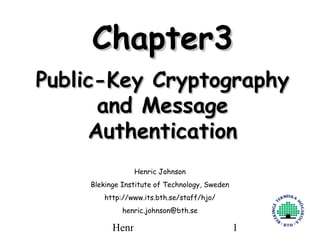
Chapter 3
- 1. Chapter3 Public-Key Cryptography and Message Authentication Henric Johnson Blekinge Institute of Technology, Sweden http://www.its.bth.se/staff/hjo/ henric.johnson@bth.se Henric Johnson 1
- 2. OUTLINE • Approaches to Message Authentication • Secure Hash Functions and HMAC • Public-Key Cryptography Principles • Public-Key Cryptography Algorithms • Digital Signatures • Key Management Henric Johnson 2
- 3. Authentication • Requirements - must be able to verify that: 1. Message came from apparent source or author, 2. Contents have not been altered, 3. Sometimes, it was sent at a certain time or sequence. • Protection against active attack (falsification of data and transactions) Henric Johnson 3
- 4. Approaches to Message Authentication • Authentication Using Conventional Encryption – Only the sender and receiver should share a key • Message Authentication without Message Encryption – An authentication tag is generated and appended to each message • Message Authentication Code – Calculate the MAC as a function of the message and the key. MAC = F(K, M) Henric Johnson 4
- 5. Henric Johnson 5
- 6. One-way HASH function Henric Johnson 6
- 7. One-way HASH function • Secret value is added before the hash and removed before transmission. Henric Johnson 7
- 8. Secure HASH Functions • Purpose of the HASH function is to produce a ”fingerprint. • Properties of a HASH function H : 1. H can be applied to a block of data at any size 2. H produces a fixed length output 3. H(x) is easy to compute for any given x. 4. For any given block x, it is computationally infeasible to find x such that H(x) = h 5. For any given block x, it is computationally infeasible to find with H(y) = H(x). y≠x 6. It is computationally infeasible to find any pair (x, y) such that H(x) = H(y) Henric Johnson 8
- 9. Simple Hash Function • One-bit circular shift on the hash value after each block is processed would improve Henric Johnson 9
- 10. Message Digest Generation Using SHA-1 Henric Johnson 10
- 11. SHA-1 Processing of single 512-Bit Block Henric Johnson 11
- 12. Other Secure HASH functions SHA-1 MD5 RIPEMD- 160 Digest length 160 bits 128 bits 160 bits Basic unit of 512 bits 512 bits 512 bits processing Number of 80 (4 64 (4 160 (5 steps rounds of rounds of paired 20) 16) rounds of ∞ 16) ∞ Maximum 264-1 bits Henric Johnson 12 message size
- 13. HMAC • Use a MAC derived from a cryptographic hash code, such as SHA-1. • Motivations: – Cryptographic hash functions executes faster in software than encryptoin algorithms such as DES – Library code for cryptographic hash functions is widely available – No export restrictions from the US Henric Johnson 13
- 14. HMAC Structure Henric Johnson 14
- 15. Public-Key Cryptography Principles • The use of two keys has consequences in: key distribution, confidentiality and authentication. • The scheme has six ingredients (see Figure 3.7) – Plaintext – Encryption algorithm – Public and private key – Ciphertext – Decryption algorithm Henric Johnson 15
- 16. Encryption using Public-Key system Henric Johnson 16
- 17. Authentication using Public- Key System Henric Johnson 17
- 18. Applications for Public-Key Cryptosystems • Three categories: – Encryption/decryption: The sender encrypts a message with the recipient’s public key. – Digital signature: The sender ”signs” a message with its private key. – Key echange: Two sides cooperate two exhange a session key. Henric Johnson 18
- 19. Requirements for Public- Key Cryptography 1. Computationally easy for a party B to generate a pair (public key KUb, private key KRb) 2. Easy for sender to generate ciphertext: C = EKUb (M ) 3. Easy for the receiver to decrypt ciphertect using private key: M = DKRb (C ) = DKRb [ E KUb ( M )] Henric Johnson 19
- 20. Requirements for Public- Key Cryptography 4. Computationally infeasible to determine private key (KRb) knowing public key (KUb) 5. Computationally infeasible to recover message M, knowing KUb and ciphertext C 6. Either of the two keys can be used for encryption, with the other used for decryption: M = DKRb [ EKUb ( M )] = DKUb [ EKRb ( M )] Henric Johnson 20
- 21. Public-Key Cryptographic Algorithms • RSA and Diffie-Hellman • RSA - Ron Rives, Adi Shamir and Len Adleman at MIT, in 1977. – RSA is a block cipher – The most widely implemented • Diffie-Hellman – Echange a secret key securely – Compute discrete logarithms Henric Johnson 21
- 22. The RSA Algorithm – Key Generation 1. Select p,q p and q both prime 2. Calculate n = p x q 3. Calculate Φ (n) = ( p − 1)(q − 1) 4. Select integer e gcd(Φ (n), e) = 1; 1 < e < Φ (n) −1 5. Calculate d d = e mod Φ (n) 6. Public Key KU = {e,n} 7. Private key KR = {d,n} Henric Johnson 22
- 23. Example of RSA Algorithm Henric Johnson 23
- 24. The RSA Algorithm - Encryption • Plaintext: M<n • Ciphertext: C = Me (mod n) Henric Johnson 24
- 25. The RSA Algorithm - Decryption • Ciphertext: C • Plaintext: M = Cd (mod n) Henric Johnson 25
- 26. Diffie-Hellman Key Echange Henric Johnson 26
- 27. Other Public-Key Cryptographic Algorithms • Digital Signature Standard (DSS) – Makes use of the SHA-1 – Not for encryption or key echange • Elliptic-Curve Cryptography (ECC) – Good for smaller bit size – Low confidence level, compared with RSA – Very complex Henric Johnson 27
- 28. Key Management Public-Key Certificate Use Henric Johnson 28